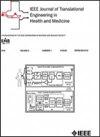功能近红外光谱和微rna早期评估抗抑郁药物治疗反应预测
IF 4.4
3区 医学
Q2 ENGINEERING, BIOMEDICAL
IEEE Journal of Translational Engineering in Health and Medicine-Jtehm
Pub Date : 2024-11-26
DOI:10.1109/JTEHM.2024.3506556
引用次数: 0
摘要
虽然功能性近红外光谱(fNIRS)先前已被建议用于重度抑郁症(MDD)的诊断,但在预测抗抑郁药物治疗反应(ATR)方面的临床应用仍不清楚。为了解决这个问题,本研究的目的是利用近红外光谱和微核糖核酸(mirna)在三个反应水平上研究MDD ATR。我们提出的算法包括基于主成分分析(PCA)的自定义主题间变异性减少。首先对无反应组进行特征提取的主成分识别。为了最大限度地减少受试者间的可变性,将前几个合计占解释方差99%的分量丢弃,而将剩余的投影向量应用于所有反应组(24个无反应者,15个部分反应者,13个反应者),以获得它们在特征空间中的相对投影。整个算法通过径向基函数(RBF)支持向量机(SVM)获得了更好的性能,与结合临床、社会人口学和遗传信息作为预测因子的传统机器学习方法相比,准确率为82.70%,灵敏度为78.44%,精度为86.15%,特异性为91.02%。所提出的自定义算法的性能表明,在适当处理受试者间可变性的情况下,可以使用多个特征源改进ATR的预测,并且可以成为临床决策支持系统在MDD ATR预测中的有效工具。临床和转化影响声明-神经影像学fNIRS特征和miRNA谱的融合显著提高了MDD ATR的预测准确性。最低要求的功能也使个性化医疗更具实用性和可实现性本文章由计算机程序翻译,如有差异,请以英文原文为准。
Antidepressant Treatment Response Prediction With Early Assessment of Functional Near-Infrared Spectroscopy and Micro-RNA
While functional near-infrared spectroscopy (fNIRS) had previously been suggested for major depressive disorder (MDD) diagnosis, the clinical application to predict antidepressant treatment response (ATR) is still unclear. To address this, the aim of the current study is to investigate MDD ATR at three response levels using fNIRS and micro-ribonucleic acids (miRNAs). Our proposed algorithm includes a custom inter-subject variability reduction based on the principal component analysis (PCA). The principal components of extracted features are first identified for non-responders’ group. The first few components that sum up to 99% of explained variance are discarded to minimize inter-subject variability while the remaining projection vectors are applied on all response groups (24 non-responders, 15 partial-responders, 13 responders) to obtain their relative projections in feature space. The entire algorithm achieved a better performance through the radial basis function (RBF) support vector machine (SVM), with 82.70% accuracy, 78.44% sensitivity, 86.15% precision, and 91.02% specificity, respectively, when compared with conventional machine learning approaches that combine clinical, sociodemographic and genetic information as the predictor. The performance of the proposed custom algorithm suggests the prediction of ATR can be improved with multiple features sources, provided that the inter-subject variability is properly addressed, and can be an effective tool for clinical decision support system in MDD ATR prediction. Clinical and Translational Impact Statement—The fusion of neuroimaging fNIRS features and miRNA profiles significantly enhances the prediction accuracy of MDD ATR. The minimally required features also make the personalized medicine more practical and realizable
求助全文
通过发布文献求助,成功后即可免费获取论文全文。
去求助
来源期刊

IEEE Journal of Translational Engineering in Health and Medicine-Jtehm
Engineering-Biomedical Engineering
CiteScore
7.40
自引率
2.90%
发文量
65
审稿时长
27 weeks
期刊介绍:
The IEEE Journal of Translational Engineering in Health and Medicine is an open access product that bridges the engineering and clinical worlds, focusing on detailed descriptions of advanced technical solutions to a clinical need along with clinical results and healthcare relevance. The journal provides a platform for state-of-the-art technology directions in the interdisciplinary field of biomedical engineering, embracing engineering, life sciences and medicine. A unique aspect of the journal is its ability to foster a collaboration between physicians and engineers for presenting broad and compelling real world technological and engineering solutions that can be implemented in the interest of improving quality of patient care and treatment outcomes, thereby reducing costs and improving efficiency. The journal provides an active forum for clinical research and relevant state-of the-art technology for members of all the IEEE societies that have an interest in biomedical engineering as well as reaching out directly to physicians and the medical community through the American Medical Association (AMA) and other clinical societies. The scope of the journal includes, but is not limited, to topics on: Medical devices, healthcare delivery systems, global healthcare initiatives, and ICT based services; Technological relevance to healthcare cost reduction; Technology affecting healthcare management, decision-making, and policy; Advanced technical work that is applied to solving specific clinical needs.
 求助内容:
求助内容: 应助结果提醒方式:
应助结果提醒方式:


